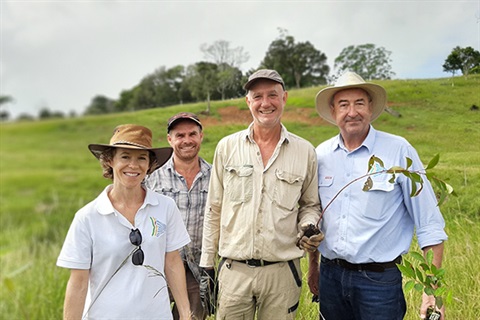
Byron Shire Council is appealing to more farmers around the Shire to consider planting koala food trees to establish suitable habitat for threatened koalas.
"We are pleased to be able to help landowners with ecological restoration that supports koala habitat through planting programs," Council's Biodiversity Officer, Liz Caddick said.
"Koalas need habitat corridors that allow them to move safely between the eastern and western reaches of the shire facilitating greater genetic diversity, which leads to healthier populations.
Often we need to use privately-owned farmland to provide these critical links and that's where our Shire's farmers come into the picture."
Ms Caddick said there were some great examples of regenerative farming successes around the Byron Shire and that these farmers had a wealth of knowledge and experience to share.
Around 10 years ago, Lindsay Murray put aside 15 percent of his cattle farm in Myocum and adopted regenerative farming practices that now provide important habitat connection for threatened koalas, as well as other wildlife.
"The land was completely cleared between 1900 and 1910 and we have been working towards establishing wildlife habitat with successive plantings every year. We hear and see koalas in the area, and koala food trees form an important part of our planting strategy," Mr Murray said.
The koala habitat planting was supported by the Saving our Species North East Hinterland Koala Conservation and Recovery Project, Byron Shire Council and Zero Emissions Byron.
To connect a Big Scrub remnant and prior habitat planting, one thousand trees were planted along a riparian corridor with primary koala food trees Swamp Mahogany (Eucalyptus robusta) and Forest Red Gum (Eucalyptus tereticornis) included in the mix.
Areas of the property where habitat has been re-established are well protected on the cattle farm.
"Planted environmental areas are electronically fenced off from cattle and we use temporary electric fencing to move the cattle around every second day," he said.
Over the past ten years of plantings, Lindsay has learnt through experience how to replant areas successfully and on a tight budget.
"Using wooden stakes makes trees easier to find during the maintenance phase, while using a hole punch or mini-auger to dig holes speeds planting up a lot. We also use old coffee sacks as mulch mats to reduce weed growth and preserve soil moisture around the seedlings."
"As a Land for Wildlife member, we are eligible for grants and support with planting projects. Every year we have an enthusiastic group of friends and neighbours who come out and help put trees in the ground," he said.






